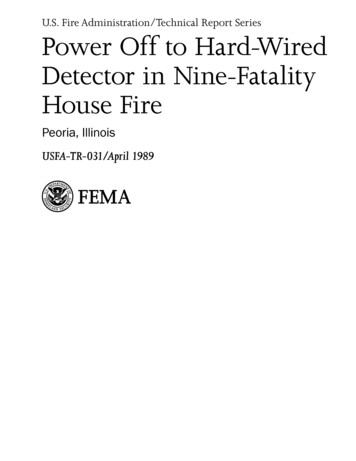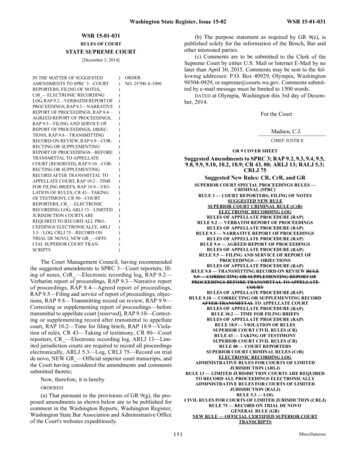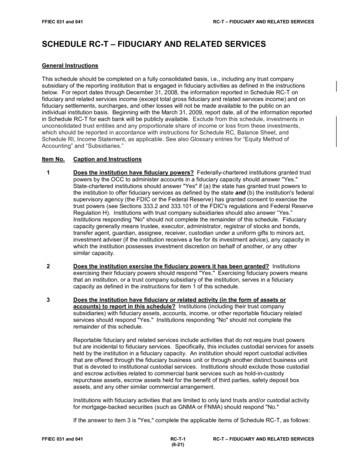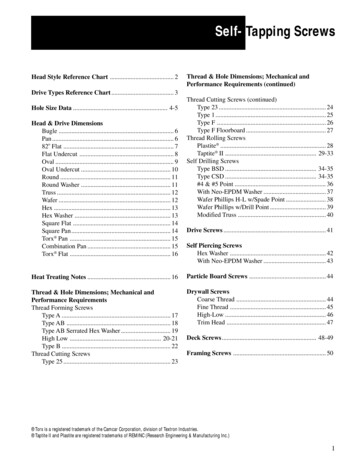
Transcription
U.S. Fire Administration/Technical Report SeriesPower Off to Hard-WiredDetector in Nine-FatalityHouse FirePeoria, IllinoisUSFA-TR-031/April 1989
U.S. Fire Administration Fire Investigations ProgramThe U.S. Fire Administration develops reports on selected major fires throughout the country.The fires usually involve multiple deaths or a large loss of property. But the primary criterionfor deciding to do a report is whether it will result in significant “lessons learned.” In somecases these lessons bring to light new knowledge about fire--the effect of building construction orcontents, human behavior in fire, etc. In other cases, the lessons are not new but are serious enoughto highlight once again, with yet another fire tragedy report. In some cases, special reports are developed to discuss events, drills, or new technologies which are of interest to the fire service.The reports are sent to fire magazines and are distributed at National and Regional fire meetings. TheInternational Association of Fire Chiefs assists the USFA in disseminating the findings throughout thefire service. On a continuing basis the reports are available on request from the USFA; announcements of their availability are published widely in fire journals and newsletters.This body of work provides detailed information on the nature of the fire problem for policymakerswho must decide on allocations of resources between fire and other pressing problems, and withinthe fire service to improve codes and code enforcement, training, public fire education, buildingtechnology, and other related areas.The Fire Administration, which has no regulatory authority, sends an experienced fire investigatorinto a community after a major incident only after having conferred with the local fire authoritiesto insure that the assistance and presence of the USFA would be supportive and would in no wayinterfere with any review of the incident they are themselves conducting. The intent is not to arriveduring the event or even immediately after, but rather after the dust settles, so that a complete andobjective review of all the important aspects of the incident can be made. Local authorities reviewthe USFA’s report while it is in draft. The USFA investigator or team is available to local authoritiesshould they wish to request technical assistance for their own investigation.For additional copies of this report write to the U.S. Fire Administration, 16825 South Seton Avenue,Emmitsburg, Maryland 21727. The report is available on the Administration’s Web site at http://www.usfa.dhs.gov/
Power Off to Hard-Wired Detectorin Nine-Fatality House FirePeoria, IllinoisInvestigated by: Daniel J. Carpenter, Jr.Charles JenningsThis is Report 031 of the Major Fires Investigation Project conductedby TriData Corporation under contract EMW-88-C-2649 to the UnitedStates Fire Administration, Federal Emergency Management Agency.Revised: March 2011Department of Homeland SecurityUnited States Fire AdministrationNational Fire Data Center
U.S. Fire AdministrationMission StatementAs an entity of the Department of HomelandSecurity, the mission of the USFA is to reduce life and economic losses due to fireand related emergencies, through leadership, advocacy, coordination, and support.We serve the Nation independently, in coordination with other Federal agencies,and in partnership with fire protection andemergency service communities. With acommitment to excellence, we provide public education, training, technology, and datainitiatives.
Table of ContentsOVERVIEW . . . . . . . . . . . . . . . . . . . . . . . . . . . . . . . . . . . . . . . . . . . . . . . . . . . . . . . . . . . . . . . . . . 1SUMMARY OF KEY ISSUES. . . . . . . . . . . . . . . . . . . . . . . . . . . . . . . . . . . . . . . . . . . . . . . . . . . . . . 2BACKGROUND. . . . . . . . . . . . . . . . . . . . . . . . . . . . . . . . . . . . . . . . . . . . . . . . . . . . . . . . . . . . . . . 2THE FIRE. . . . . . . . . . . . . . . . . . . . . . . . . . . . . . . . . . . . . . . . . . . . . . . . . . . . . . . . . . . . . . . . . . . . 3CASUALTIES. . . . . . . . . . . . . . . . . . . . . . . . . . . . . . . . . . . . . . . . . . . . . . . . . . . . . . . . . . . . . . . . . 4FIRE CAUSE AND SPREAD . . . . . . . . . . . . . . . . . . . . . . . . . . . . . . . . . . . . . . . . . . . . . . . . . . . . . . 4ESCAPE ROUTES AND OCCUPANT ACTIONS. . . . . . . . . . . . . . . . . . . . . . . . . . . . . . . . . . . . . . . 5CODE COMPLIANCE. . . . . . . . . . . . . . . . . . . . . . . . . . . . . . . . . . . . . . . . . . . . . . . . . . . . . . . . . . . 6SMOKE DETECTORS. . . . . . . . . . . . . . . . . . . . . . . . . . . . . . . . . . . . . . . . . . . . . . . . . . . . . . . . . . . 6IMPACT ON FIREFIGHTERS. . . . . . . . . . . . . . . . . . . . . . . . . . . . . . . . . . . . . . . . . . . . . . . . . . . . . 7LESSONS LEARNED. . . . . . . . . . . . . . . . . . . . . . . . . . . . . . . . . . . . . . . . . . . . . . . . . . . . . . . . . . . . 7Supplement: Fire Kills Five Children in Townhouse with Working Smoke Detector. . . . . . . . 9THE FIRE. . . . . . . . . . . . . . . . . . . . . . . . . . . . . . . . . . . . . . . . . . . . . . . . . . . . . . . . . . . . . . . . . . . . 9CONCLUSION. . . . . . . . . . . . . . . . . . . . . . . . . . . . . . . . . . . . . . . . . . . . . . . . . . . . . . . . . . . . . . 10APPENDICES. . . . . . . . . . . . . . . . . . . . . . . . . . . . . . . . . . . . . . . . . . . . . . . . . . . . . . . . . . . . . . . . 11Appendix A: Floor Plans. . . . . . . . . . . . . . . . . . . . . . . . . . . . . . . . . . . . . . . . . . . . . . . . . . . . . . 12Appendix B: Map of Downtown Peoria Showing Fire Location and Station Locations. . . . . . 14Appendix C: Photographs . . . . . . . . . . . . . . . . . . . . . . . . . . . . . . . . . . . . . . . . . . . . . . . . . . . . 15Appendix D: Fire Department Report Concerning Status ofSmoke Detectors in Fire Building. . . . . . . . . . . . . . . . . . . . . . . . . . . . . . . . . . . . . . . . . . . . . 19
Power Off to Hard-Wired Detectorin Nine-Fatality House FirePeoria, IllinoisApril 11, 1989Local Contacts:G. John Parker, ChiefErnest E. Russell, Assistant Chief/Chief of Fire PreventionRoy T. Modglin, Battalion Chief District #1Robert Chappell, CaptainBob Sollbergan, EngineerPeoria Fire DepartmentFire Central505 N.E. Monroe StreetPeoria, Illinois 61603-3767OVERVIEWA fire originating in the first floor of a two-story, wood-frame house with two rental units in Peoria,Illinois, killed two adults and seven children on April 11, 1989. Two other adults and a teenager wereinjured, though they were able to escape from the burning house onto a porch roof from a secondstory window. This was the worst life-loss fire in Peoria for at least the past three decades.Although the house was equipped with hard-wired smoke detectors on each floor, the electricityon the circuit powering the first floor detector had been turned off inadvertently when the powercompany disconnected power to the first floor apartment for non-payment of bills. The detectorson both floors were wired on circuits individual to each apartment. The second floor detector waswired correctly and had power, but whether it operated during the fire was not determined.The rest of the scenario is all too familiar: an apartment overcrowded with multiple families and ahigh ratio of young children to adults. They did not become aware of the fire until late in its development. All of the fatalities were attributed to high carbon monoxide levels. Autopsies revealed thatdrugs or alcohol did not contribute to the deaths.
SUMMARY OF KEY ISSUESIssuesCommentsFire CauseArson by an acquaintance of the victims.Casualties9 dead, including 7 children aged 2 months to 10 years old; 3 injured, including two adults, oneyouth.Smoke DetectorsHard-wired smoke detectors were present on the first and second floors.Power to the first floor apartment had been disconnected for delinquent payment. Powercompany not aware of potential impact on detectors.OvercrowdingTwelve people occupied the 600 square foot apartment originally rented to a mother and herthree children.Covered WindowsSeveral windows had been covered with drywall before the fire, although each room had atleast on other window.Open DoorA door left open at the foot of the stairs leading to the second floor probably contributed torapid fire spread.Firefighter StressPost-incident traumatic stress among the firefighters was mitigated by prompt use of a debriefing team.Victim BehaviorSeveral young victims were found directly in front of window leading to porch roof.The cause of the fire was arson. It was started in a rollaway bed in the vacant first floor apartment bya visitor who had been asked to leave the second-floor apartment. He has been charged with ninecounts of murder and two counts of aggravated arson.BACKGROUNDThe property involved was a two-story frame house with two rental units, one upstairs and the otherdownstairs. The dwelling had a history of city building code violations dating back to 1965, withviolations again in 1978, 1979, and 1980. These violations were apparently corrected. No recordwas found of the building being inspected again for building violations in the nine years before thefire. Several windows and doors were boarded up at the time of the fire.According to the owner of the two-story frame house, the second floor apartment was rented toTerry Davis and her three children, Arnisha, Carlyssa, and Tanoa Davis. Her sister’s family (Hobbs)and her former downstairs neighbor’s family (Barnes) also lived there. The owner said he was notaware that three families with twelve people were living in the 600 square foot apartment at thetime of the fire. The city housing code requires 150 square feet of living space for the first occupantand 100 feet for each occupant thereafter. The space was clearly overloaded at the time of the fire.“This may have hampered the escape of some of the occupants,” according to Peoria Fire Chief G.John Parker.One of the three families on the second floor was headed by Joyce Barnes. Her family had beenoccupying the first floor apartment until just a few days before the fire, when she moved upstairswith the Davis and Hobbs families. The electric company had disconnected the power to her firstfloor apartment on April 4 (a week before the fire) as a result of delinquent bills, which stimulatedher move.
USFA-TR-031/April 19893Shortly before the tragic fire on Monday, April 10, four adults and eight children were asleep in theupstairs apartment. At approximately 2330, a male visitor, age 34, was asked to leave as the otherswere going to bed. He remained in the neighborhood and re-entered the vacant downstairs apartment through a window at approximately 0200 hours on Tuesday. In preliminary interviews byBureau of Alcohol, Tobacco and Firearms (ATF) and police investigators, the man said he accidentallyset a fire on a rollaway bed in the living room/hallway of the first floor apartment. In subsequentinterviews he allegedly admitted to intentionally setting the fire.Once again, the fire quickly spread to the second floor where the occupants were sleeping.THE FIREAt 0220, the fire was reported to the Peoria Fire Department by the people living in the house nextdoor. One of these neighbors told firefighters that “the fire was just blazing all of a sudden.” Theneighbors observed “fire coming, from upstairs, and people jumping.” Upon arrival four minuteslater at 0224, District #1 Battalion Chief Roy Modglin observed a working fire involving both thefirst and second floors. He immediately called for a second alarm. Two of the occupants trapped onthe front porch were quickly rescued, and they, plus one of the occupants who had jumped from theroof to the ground in the front yard, were treated and sent to local hospitals.Recognizing the severity of the situation and the progress the fire had already made, Chief Modglinrequested other units to “step it up.” He also requested paramedics and additional ambulances, having learned that several small children were still trapped on the second floor.Two engines, a rescue unit, a truck, and a battalion chief comprised the first alarm response. Theseunits made an immediate attack to control the fire, and rescue operations were begun. One and threequarter inch hoselines were advanced to the interior of the first floor to protect the stairwell, withthe second line (1-1/2-inch) taken to the north side (the back) of the building. See Appendix A forthe floor plan. Ladders were raised on all sides of the building to expedite rescue attempts. ChiefModglin requested additional staffing with airpacs to the scene. He also requested that additionalambulances, senior officers, and the coroner’s office be notified.As firefighters from the rescue unit and engine companies gained entrance through the front door,fires were knocked down on the first floor and up the stairway to the second floor. Knowing theprimary objective in this situation was to rescue the occupants still trapped in the building and notknowing if anyone were still alive, effort was made to bring the fire under control only to the extentthat rescue could be accomplished. Each time the fire gained sufficient headway to make rescueattempts impossible, the firefighters were obliged to re-direct their efforts to knock down and control the fire. This procedure may have allowed the fire to burn parts of the building more extensivelythan if all fire suppression efforts were directed to extinguish the fire. However, under similar circumstances, such efforts have saved lives and seem well justified. Unfortunately, the victims in thisfire were in all likelihood beyond help at this point anyway.The fire was confined to the building of origin. The interior of the building was extensively burned.The rapid spread of the fire up the stairwell was evidenced by the extensive burning in this area as wellas by the severe smoke and burn patterns around the north wall window at the head of the stairwell.As the fire was brought under control, search and rescue attempts were conducted. These attemptswere somewhat hindered by a lack of adequate breathing air supply for the first crews on the sceneand also the rekindling of the fire throughout the building.
Ladder company personnel subsequently gained access to the roof and cut two holes to begin ventilation procedures. Additional ladders and hoselines were eventually placed on all sides of thebuilding.Seven victims were discovered in the front room on the south side of the building. One other victimwas found in the hallway at the top of the stairs and one in the center bedroom at the north side.Some were pronounced dead at the scene, others at hospitals. Four of the children’s bodies werefound within four feet of the windows leading to the porch roof. Indications are that the childrenmay have been brought to the front room by their parents, or gone there to be with their parents,and were overcome by smoke before they could get out or be helped out of the building.As additional victims were discovered, additional staffing and ambulances were summoned untilapproximately 40 personnel arrived at the scene. Backup units were called in to provide cover forthose companies at the scene.While rescuing two of the occupants from the front porch, two firefighters received minor backstrains and pulled arm ligaments.CASUALTIESAt the time of the fire, all of the occupants of this two-story, wooden frame dwelling were living inthe second floor apartment. All were killed or injured. The people killed by the fire were:Terry Davis, 27;Arnisha Davis, 7;Carlyssa Davis, 2;Tanoa Davis, 10;Wanda Hobbs, 20;Felicia Hobbs, 3;Ashley Hobbs, 1;Jacolby Thomas, 2;Eugene Young, 2 months.Those injured were:Joyce Barnes, 30 (critical injured but survived; sent to the burn unit at St. Francis Medical Centerin Rock Island, Illinois).Eric Davis, 14; son of Joyce Barnes and Carl Wells (sent to same burn unit);Carl Wells, 29 (treated and released).FIRE CAUSE AND SPREADIn the City of Peoria, Illinois, the fire marshal has the responsibility to determine the origin and causeof fires. In the event a fire is determined to be of an incendiary nature the police department assistsin the investigation and continues with the case. The ATF also offered assistance in this incident.
USFA-TR-031/April 19895Fire investigators confirmed that the fire was started on the rollaway bed. “V” patterns on the wall inthis area attest to the fire having burned upward and outward in this spot. The fire was determinedto have been intentionally set with burning newspapers used to ignite the bedding. There were noindications that a flammable liquid had been used. Accidental causes were eliminated, including agas space heater also located on the first floor of the dwelling that was originally considered as apossible cause of the fire.Based on burn patterns, a door at the foot of the stairs leading to the second floor was either openbefore the fire started or opened during the fire, possibly by the adult male victim who tried toescape down the stairs, then went back up the stairs and out the window to the porch roof. Thatopen door contributed to the rapid spread of smoke and flames to the second floor.Smoke also spread to the upstairs apartment through the chases going from the first floor to thesecond floor. Ultimately, the fire spread rapidly inside the walls and up the stairway to the secondfloor. Several other windows were boarded up, which hampered firefighters gaining entry to fightthe fire.ESCAPE ROUTES AND OCCUPANT ACTIONSThe question remains as to why seven of the victims were all found in the front room but did notescape. Four of the children (a 2-month old, two 2-year olds, and a seven-year old) were found atthe windows, quite possibly put there or led there by the two adult women who died. These womenwere found near the interior entrance to a storage room through which access could be gained tothe bedroom where one of the other children was found. Were the children responding to the directions of an adult member of the household in the hope of exiting through the front window ontothe porch roof, as the other occupants who survived had done? Did they gather but then not escapebecause the adults succumbed? Did the upstairs smoke detector alert the occupants?One of the survivors, Carl Wells, told firefighters he had tried to go downstairs but when he felt thedoor at the foot of the stairs (which he thought was closed at the time) he realized that this door wastoo hot. He then went back up the stairs and out through the front window onto the porch roof. Hedropped from the roof to the ground, sustaining a slight injury.Because the performance of the upstairs smoke detector is unknown, several scenarios emergedepending on the status of the detector and exact sequence of the occupants’ investigation activityand escape activity. Regardless of whether the upstairs detector was or was not functioning, smokefrom the fire downstairs had not yet reached a heavy level in the upstairs apartment when Wells wentdownstairs to investigate conditions on the first floor. Wells retreated up the stairs and, judging fromhis position on fire department arrival, escaped severe smoke and heat conditions by seeking refugeon the porch roof. The position of the other occupants would indicate that they were alert and initiating some action concurrent with the investigation activity. The investigation could have been initiated by the activation of the smoke detector, with occupants taking little action beyond awakening,or could also have been initiated by Carl Wells after he discovered the fire downstairs. Their delayedawareness of the fire and the sudden influx of fire products left insufficient time for escape.The answers are not known, but the circumstance is common. The rapid accumulation of toxic gasescoming up the stairway did not afford much time to escape – especially if the adults were confrontedwith too many children to handle, and if they had not practiced escape drills. The adults who perished also may have been faced with a difficult decision – whether to try to find the remaining two
children or to leave with some of the children who were not immediately in the path of the flames.Also, they, like most people, may not have realized the deadliness of the gases and how fast conditions can deteriorate.As noted earlier, some of the windows and doors on the first and second floors were boarded upor blocked by heavy appliances. This probably did not impede escape in this particular situationbecause there appeared to be adequate egress through the remaining windows if one were willingto climb out or jump. Several of the windows were high enough from the ground to deter a childfrom jumping, and perhaps also an adult, if they were not trained or helped to do so. Even jumpingonto the porch roof may not have been obvious or feasible for the children.CODE COMPLIANCEThe house had a history of building code violations dating back to 1965, but the last one was in1980. Since then there was no record of any inspections for building code violations, only environmental inspections.Possible violations of the City Housing Code were investigated after the fire, especially with regardto the boarded up windows and doors. They were judged not be a violation because of an adequatenumber of remaining windows in each room. However, a permit usually must be issued before suchboarding can be done. No such permit had been obtained by the owner or the occupants prior tothe fire. Two windows were boarded on the second floor. On the first floor, a front door and a rearwindow were also boarded up. According to the owner, the upstairs windows were boarded beforehe purchased the building, while the downstairs windows were boarded up to “keep burglars out.”SMOKE DETECTORSThe City of Peoria has adopted the Building Officials and Code Administrators (BOCA) National FirePrevention Code of 1987. They also passed an ordinance in 1975 requiring smoke detectors in allapartment buildings. The State of Illinois also passed a similar law in December 1987. Both cityand State laws require all houses to have smoke alarms near sleeping areas. Both require detectorsto be retrofitted in all apartment houses with three or more units. In 1983, Peoria also requiredhard-wired detectors in all new residential properties regardless of size, including one or two familyhomes. The owner of the fire building, which was equipped with hard-wired smoke detectors, wasnot required to install hard-wired detectors and actually exceeded the minimum requirements of thecode in effect at the time of installation.Installation and repair of smoke detectors in rental properties is the responsibility of the landlord.Failure to comply is a misdemeanor and is punishable by a fine and/or jail sentence. Routinemaintenance, such as dusting or changing batteries is done by the tenant. Removal of batteries ortampering with a smoke detector is a violation punishable by a fine and/or a jail sentence.The owner of the fire property stated that hard-wired smoke detectors had been installed on boththe first and second floors and were connected to the main electrical system. Fire investigators confirmed that hard-wired smoke detectors (FIREX) were present at the time of the fire.The electrical power to the empty first floor apartment had previously been shut off because ofunpaid bills. This disabled the first floor detector, which was where the fire started. It is believed thatif both smoke alarms had been operable, some or all lives may have been saved. The family upstairsmight well have heard the downstairs alarm and had more time to escape.
USFA-TR-031/April 19897IMPACT ON FIREFIGHTERSA feeling of depression and frustration prevailed among firefighters as they continued to relive theevents of this tragic fire. Even knowing that every possible effort to rescue the seven children andtwo adults who perished in the fire had been made, it was not enough to eliminate this traumaticevent from their minds.Recognizing the post-incident traumatic stress of the firefighters, a debriefing by experts from aCritical Incident Debriefing Team was requested by Chief John Parker to help them cope with thepsychological aspects of the fire.While almost 40 firefighters responded to the scene, those who were believed to have had the greatest exposure and were thought to be the most at risk for traumatic stress disorder were those whoarrived first at the scene. “The frustration of trying to locate survivors, only to find victims, many ofwhom were children, must indeed take its toll of even the most experienced firefighter,” said ChiefParker.The debriefing team, which was comprised of nurses, fellow firefighters who had experiencedsimilar situations, medics, and counselors, was assembled in Champaign, Illinois, and brought toPeoria. Sessions at the Central Fire Station were thought to be very beneficial according to firefighters interviewed.One of the primary benefits of this program was the team’s ability to assemble and respond shortlyafter being alerted. Their prompt arrival allowed Peoria firefighters to discuss this tragic experiencewith other professionals and thereby alleviate some of the feelings of anger, depression, frustration,and loss that is normally associated with this type of experience.LESSONS LEARNED1. Power companies need to be alerted to the possibility of disabling smoke detectors whenthey shut off power to a residence.Most power companies are very aware of the potential for electrical fires, but they may not beequally aware of the potentially disastrous effect on early fire detection when they terminateelectrical service to a residence.Fire departments should attempt to work out an arrangement with the local power company toassure that the appropriate official is notified when the power gets turned off. This is especiallyimportant when city ordinances require hard-wired systems that might be disabled by a powerturn-off when the building code requires electric service for safe occupancy of a dwelling.2. Hard-wired smoke detector installation ordinances should specify that detectors are wiredin such a way that turning off electricity to one apartment or unit does not disable smokedetectors through the building.Although the detectors in this fire were properly installed, the possibility that both detectorswere disabled was considered early in the investigator.Each community should inspect or develop ways to assure that hard-wired detectors are properly installed so that a selective power disconnect will not disable all the smoke detectors in abuilding.
3. Overcrowded apartments can lead to a disaster when fire occurs.The supply of adequate housing to prevent overcrowding cannot be addressed by fire departments. However, fire departments can warn people in low income areas of the terrible risk theyrun by overcrowding, especially when many small children are present. This fire and otherssimilar to it in Milwaukee and Prince George’s County, Maryland, to name just two, might becited as examples.1 4. Low income renters are a target group in special need to escape drill training andmotivation.Exit drills are well known, but not widely practiced, especially in low income areas. Knowingand having practiced how to get through a window onto a roof might have enabled more of theoccupants in this fire to escape once their usual exit route down the stairs and out the front doorwas blocked by fire. The need to be familiar with alternate escape routes should be stressed allthe more in areas where there may be overcrowding, and in homes with young children. Thenature of fire and smoke, the short time to react, and the need to exit via windows, if necessary,should all be addressed.5. Windows must be kept free from barriers.Several windows here were boarded up. That not only reduces the number of exits, but can addconfusion in a smoky fire situation. The boarded windows in this particular fire may not haveaffected escape opportunities because there were two unboarded windows close to the front ofthe house overlooking the porch roof. Nevertheless, the boarding reduced escape options andwas cited as interfering with suppression and rescue efforts.6. Building code violations affecting escape are especially important to remedy.Inspecting for code violations in rental one and two-family residences is usually a low priority in most communities. It often is the responsibility of the building department. Getting aspeedy resolution of problems in low income areas with absentee landlords can also be difficult.Nevertheless, it is a life safety issue and should be addressed by local authorities. Most peoplewho die in fires do so in one and two family homes.7. Firefighter stress after multi-casualty fire needs immediate attention.Peoria acted very promptly to get psychological assistance for the firefighters involved in thistragedy, which helped mitigate the impact on the department. “Four House Fires That Killed 28 Children, “U.S. Fire Administration, Federal Emergency Management Agency, 1988.
SupplementFire Kills Five Children in Townhouse withWorking Smoke DetectorAnnapolis, MarylandOn January 25, 1989, a fire originating on the first floor of an Annapolis, Maryland, townhouse-styleapartment killed five children and injured four adults, three of whom exited via windows on thesecond floor. An operational smoke detector was in-place outside the second floor sleeping area.Though the smoke detector worked it failed to assure the life safety of the occupants. Conditionsfound in the house are not uncommon in households, generally.THE FIREThe fire originated in an upholstered chair in the living room and was caused by a carelessly discarded cigarette. One visitor was sleeping downstairs, th
on both floors were wired on circuits individual to each apartment. The second floor detector was wired correctly and had power, but whether it operated during the fire was not determined. . The dwelling had a history of city building code violations dating back to 1965, with violations again in 1978, 1979, and 1980. These violations were .











